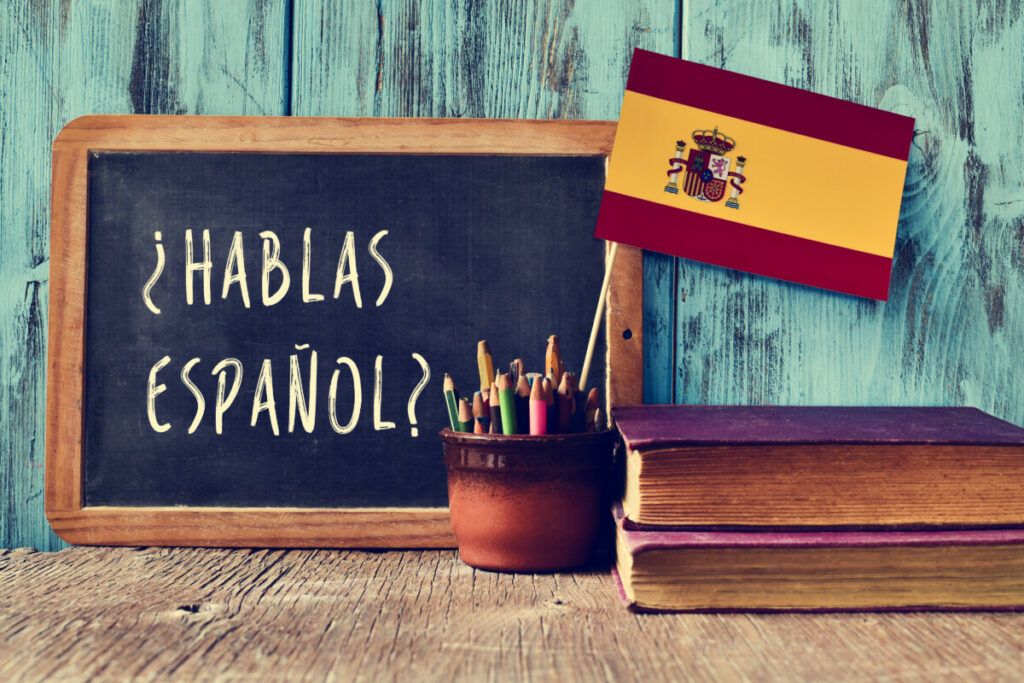Learning a new language can be a daunting task, and there are some languages that are more difficult to learn than others. When trying to learn your first foreign language it would be smart to choose an easier one. I myself chose to learn Spanish when starting out learning other languages.
Spanish is an easy language to learn. Despite Spanish being a Romance language while English is a Germanic language, Spanish and English have a lot of similarities. These similarities are what make learning Spanish so easy. Someone can learn Spanish in 24 to 30 weeks if they are committed.
As you can see Spanish is a simple language that is great for a beginner. Yet, how fast you learn Spanish is based on a lot of different factors. Read on to understand the challenges of learning Spanish.
Foreign Service Institute on Spanish
Harry Truman created the Foreign Service Institute in 1946 as a way to help the United States grow in its cultural understanding to help with its diplomatic future. The Foreign Service Institute’s main purpose is to help train people in the US Government to be able to establish intercultural relationships, which includes teaching governmental employees how to speak a multitude of languages.
The Foreign Service Institute has done a lot of research due to its mission on the processes of how to learn a language. They have researched which languages need more time and which ones are much quicker to master than others. The Foreign Service Institute has found that there are four different categories of language difficulty. Category 1 languages are the languages most similar to English. It takes a person on average 24 to 30 weeks or 600 to 700 class hours to be conversational in these languages. Category 2 languages are slightly harder. They take approximately 36 weeks to learn or 900 class hours.
Category 3 languages are considered hard languages. They have significant linguistic and/or cultural differences from English, so it takes roughly 44 weeks or 1100 class hours to learn those languages. Finally, the fourth language category is a very hard language, which is exceptionally difficult for English speakers to learn, which is why it takes 88 weeks or 2200 class hours to learn these languages.
As you can see, there is a lot of variety between the categories which is why it is significant to say that Spanish is the first category of languages. This means it takes roughly 24 to 30 weeks or 600 to 700 class hours to learn Spanish. This is great news for those learning Spanish. You can expect to be conversational in Spanish within a year.
European Framework of Reference for Languages

Now here is the thing it is what does speaking Spanish truly mean? At what point can you say that you speak Spanish? The European Framework of Reference for Languages has come up with a comprehensive way to rate your language learning skills. The European Framework of Reference for Languages has explained how long it would get to each level of fluency in Spanish.
The first level is A1, which covers very basic grammar and vocabulary words. You would just have the foundation of Spanish at this level It should take a person around 70 to 80 hours of study to reach the A1 level, which typically takes between 2 and 3 months.
The next level is A2. A person in A2 should be able to understand and produce basic Spanish sentences in simple everyday situations. This level requires roughly 80 to 100 hours of additional study after reaching A1. This means you can expect to hit A2 within 4 to 7 months.
Our next level is B1, which is when you are actually able to hold conversations in Spanish. This level and the next B level are going to take the longest time to learn because this is where you learn the meat of a language.
You will need an additional 150-180 hours of Spanish Study to reach level B1. This means it would probably take you 6 months to get to this stage, but if you do more intensive study, you can get there in maybe 3 months. All together though you can expect to get to B1 within 300-360 hours of work, which will likely take you 13 months to complete.
B2 is the next level. At B2, you will be able to have casual conversations with native Spanish speakers with only little difficulty. This is the stage where you may feel like the learning curve is slowing down and you are getting stuck. It is hard to get over this hump. This phenomenon is called the intermediate plateau.
You will have to study for an additional 240-260 hours after reaching B1 to get to B2, which shows the difficulty of getting to this level. It will take you roughly 10 months to get to this level, but if you are learning at a fast pace you can get to this stage in 4 months. This means that, altogether, you would have studied for 540-620 hours or 2 years.
The next level is C1. Surprisingly, C1 is where learning Spanish becomes easier again. You will be completely conversational in Spanish at this level and should be able to communicate comfortably in almost every situation. To get to C1 from B2, you will need to study for around 200-240 hours. This should take you around 4 to 7 months to reach. So, altogether you would have studied 740-860 hours or 2 and a half years.
Finally, you have mastered Spanish when you hit C2, which is when you are completely fluent in Spanish. It will require 180-240 hours of work to reach this level after C1, which equates to roughly 3 to 6 months of work. All together according to the European Framework of Reference for Languages it will take you 920-1100 hours or 1.5 to 3 years to learn Spanish.
Age
Age has a large factor in how fast you can learn a language. Research has shown that the best age to learn a second language is from 8 to 12 years of age. Still, language acquisition levels stay up at a high rate until a person turns 18. Once someone turns 18, their language learning skills decrease.
There are many reasons for this. It could be because of the brain’s development, but many scientists argue that it is because of the pressures of adulthood. There is not as much time in adulthood for regular language study, which is needed for rapid language growth.
Still, scientists do agree there is a biological component to language acquisition. It was shown that students who have immigrated from another culture usually take four years when they are in elementary school to catch up to the same language level skills as their peers. Yet, an immigrant in high school under the same language learning circumstance could take up to 8 years to learn the language as well as their peers. This proves that there has to be a level of biological development component to the speed of language acquisition.
Overall, if you are older, it will take you a long time to learn a language than if you were younger. Therefore, if you are a parent introduce your child to the joys of learning a second language at a young age. They will be more successful later in life if you do.
Romance Languages vs Germanic Languages

Now, if you are very interested in the genealogy of languages, you would probably be aware that English is not closely related to Spanish at all. There are several families of languages. English is actually a Germanic language, which, as the name states, means that English is more similar to German, Swedish, and Icelandic than Spanish. These languages all share a common mother language that they split off from to form their own language.
Spanish, on the other hand, is a Romance Language. Other romance languages are Italian, French, and Portuguese. Therefore one would expect that Spanish would be very difficult to learn since it is from an entirely different language family tree. Luckily, it is not that bad. Both Romance languages and Germanic languages originate from the Indo-European family of languages. The Indo-European family of languages is heavily influenced by Latin and French. This impacts the English language greatly.
When studying Spanish, you are bound to find some words that are the same in Spanish as in English. For instance, the word hospital in English is also hospital in Spanish. The pronunciation is varied slightly, but it does indicate that there is a relative share between English and Spanish words.
It is suggested that 30-40% of English words have a Spanish cognate. This means that 30-40% of English words have a word in Spanish that sounds and looks slightly like the English version.
Still, there are some major differences. For instance, the grammar of Spanish is very different from English. This is why it can be difficult to learn Spanish even though it is a relatively easy language to learn.
Exposure
How fast you learn the language also is dependent on the resources you have available. The best way to learn a language is through language immersion. Being around a language all the time is going to give you the opportunity to talk with people in that language often. It forces you to learn that language or not talk. The added pressure is good, but the practice is what is really going to help you.
Therefore, the more opportunities you have to be around the language you are learning the faster you are going to learn the language. If you can go and visit a Spanish-speaking country or someone who is a Spanish Speaking Native, you should be able to learn faster than those who do not have access to these benefits.
When I first started learning Spanish, I was forced to speak only Spanish all the time for 6 months straight. I went on a religious mission and this was where I learned the most Spanish in my life. I had no instructors, just a small textbook with some grammatical principles and vocabulary words along with access to Google Translate. That was my Spanish education, and I learned so much.
When I returned home, I started attending Spanish classes at college. I had a highly educated college professor who I met every day for an hour to learn grammatical principles and vocabulary. I would then have another hour of homework to complete at night.
Yet, I felt that I learned much faster when I was only allowed to speak Spanish, despite all the professional help I was getting. This was because I was no longer speaking to Spanish natives. I no longer was learning from people who lived and breathed speaking Spanish. My progress slowed down, therefore, your progress likely could benefit from speaking with natives and could make learning Spanish easier and faster.
Dialects

Finally, there are lots of different Spanish Dialects. 20 countries in the world speak Spanish. If you even look at the difference between England’s use of English and America’s use of English, you will find differences in how we say things and what words we use to say them. It is the same way with Spanish.
Spanish isn’t just different in different countries. In different areas of a country, there are dialectical differences, much like how the South of America and the North of America have different accents. These differences can make learning Spanish a challenge.
Mastering Spanish is very difficult because to truly be a master of Spanish, you need to be able to understand all of the different dialects. Other languages like German have fewer different dialects. Only 5 other countries besides Germany use German as their primary language. This is much smaller than Spanish. Only being able to speak one region of Spanish is not going to prepare you for all social exchanges in Spanish. This is going to add more time to your learning process.
